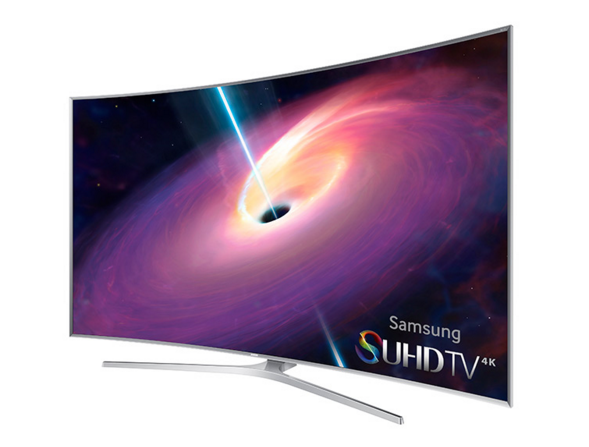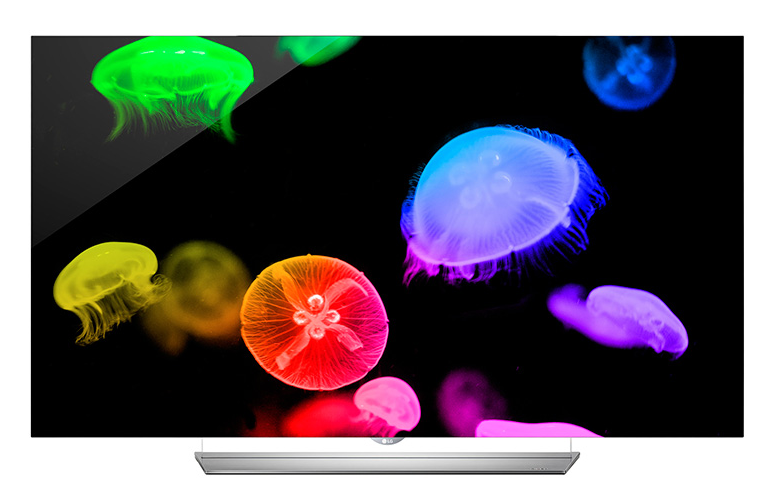In the continuous battle of 4K TV brands, numerous technologies from major manufacturers are competing to show consumers that they offer the sharpest display quality for their money. Out of them all, there are two dominating giants whose products have certainly caught the consumer’s eye: Samsung’s SUHD TV and LG’s OLED TV. Both have paved the way to the top in the quality of display color, brightness, clarity, and realism offered in a 4K TV. So what sets them apart? Let’s have a look.
SUHD

The 65-inch curved 4K SUHD TV from Samsung. Image source: samsung.com.
SUHD (Super Ultra High Definition) is Samsung’s brand name behind its range of 4K Ultra HD TVs. As with 4K Ultra HD TVs, SUHD TVs have about four times as many pixels as standard 1080p Full HD TVs packed into the display panel. This calculates to a resolution of 3840 x 2160 pixels, compared to standard Full HD TVs, which boasts a resolution of 1920 x 1080 pixels. Currently models come in a variety of sizes including 88 inches ($19,999), 65 inches ($4,199), and 78 inches ($7,999).
At their heart, SUHD TVs are backed with LCD technology. Most have curved screens, and are basically LED-backlit televisions with Ultra HD 4K resolution. But then it gets interesting.
As most already know, quantum dots have been making quite the splash in the pool of 4K TV displays, and this includes SUHD TVs, which focus on the use of quantum dot nanocrystal layers in their screens to create a complex palette of color tones. Dubbed by Samsung as Nano-Crystal technology, the quantum dots or nanocrystals are enhanced by LED backlights, which expand how many colors appear, and how lively they look.
In principle, this sounds, and is, awesome. But with today’s sources, this technology can only somewhat improve a television’s color. The main benefit will not be realized until wide color gamut content becomes more common, which it should within the coming years.
As it competes with rivals such as LG, we can expect refinements from Samsung with improvements to displays beyond upping the pixel count.
OLED

LG's 65-inch OLED TV. Image source: lg.com.
While SUHD TVs focus on the use of quantum dot nanocrystal layers in their screens, LG’s OLED TVs offer the deepest blacks possible because of their organic light emitting diodes, which can individually shut themselves off where needed for a particular image. LG also promises deep, vibrant colors while Samsung touts HDR compatibility as a darkness enhancing feature of its own TVs.
In terms of quality, LG’s OLED 4K advantages are similar to the benefits of plasma over LCD TVs. They provide better side viewing angles, improved black levels, and they have no problems with backlight uniformity interfering with contrast. Currently models include the 55-inch Class 1080p Curved OLED Smart TV ($1,999) and the 65-inch Flat OLED 4K Smart TV ($4,999).
Another difference worth mentioning is that Samsung SUHD models offer the company’s streamlined Tizen OS for smart TV controls, and LG’s OLED 4K line uses the operating system known as webOS, originally developed by Hewlett Packard. According to LG, its operating system is lighting fast and intuitive.
When it comes to sheer connectivity, the latest in HDMI, web apps, and other connection features, both TVs are basically an even match, although Samsung offers its connection ports through an external and upgradable OneConnect box that makes the process of changing to meet new connection standards simpler.
The bottom line
So which TV is crowned victorious? Overall, it’s obvious that Samsung’s SUHD TVs are built with the next generation of HDR content in mind. Although they lack a few features that LG’s OLED TVs offer, they’re designed to be compatible with new upcoming content technology, and for what they offer for the price, they’re the better buy. While not as capable of creating perfect dark tones as OLED technology, their LCD LED screens make them superior at displaying HDR due to a better luminance than that found in OLED.
Related Products: Displays
Advertisement
Learn more about Electronic Products Magazine





